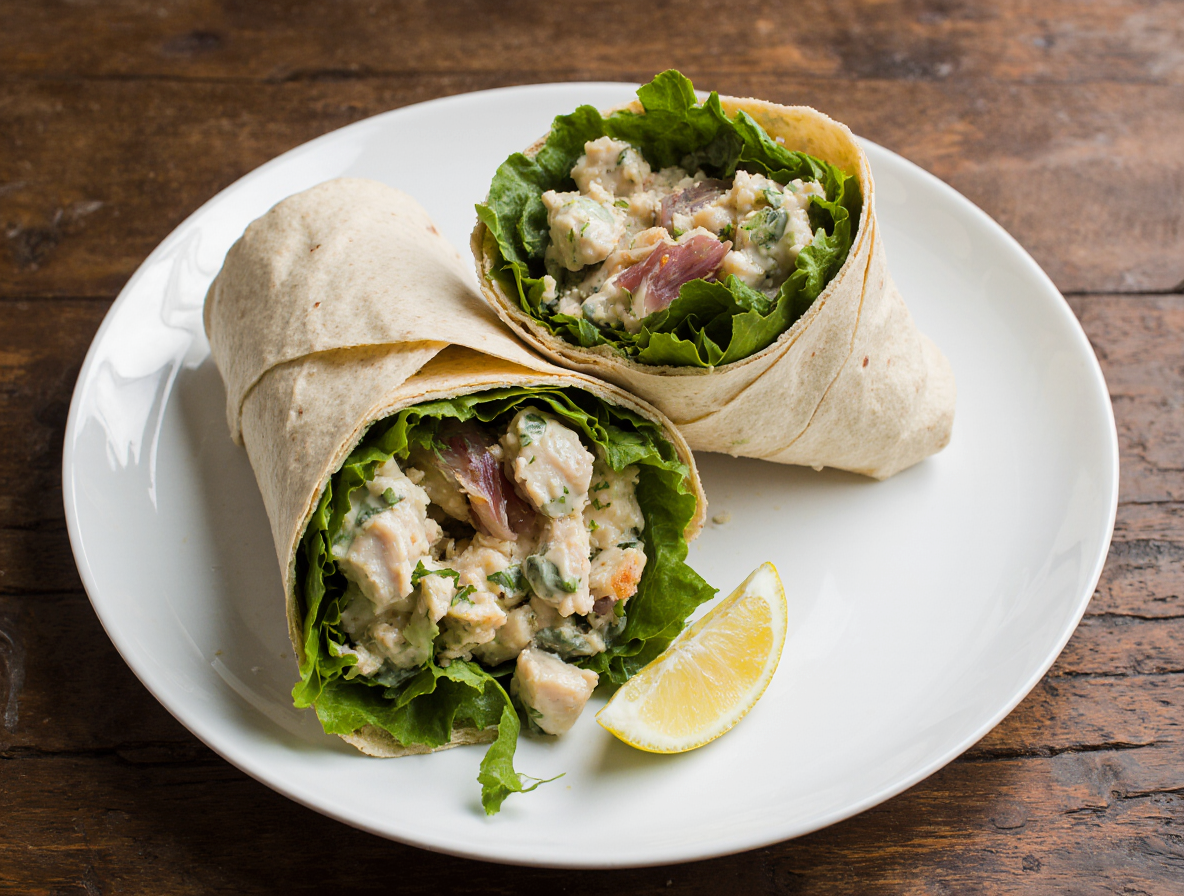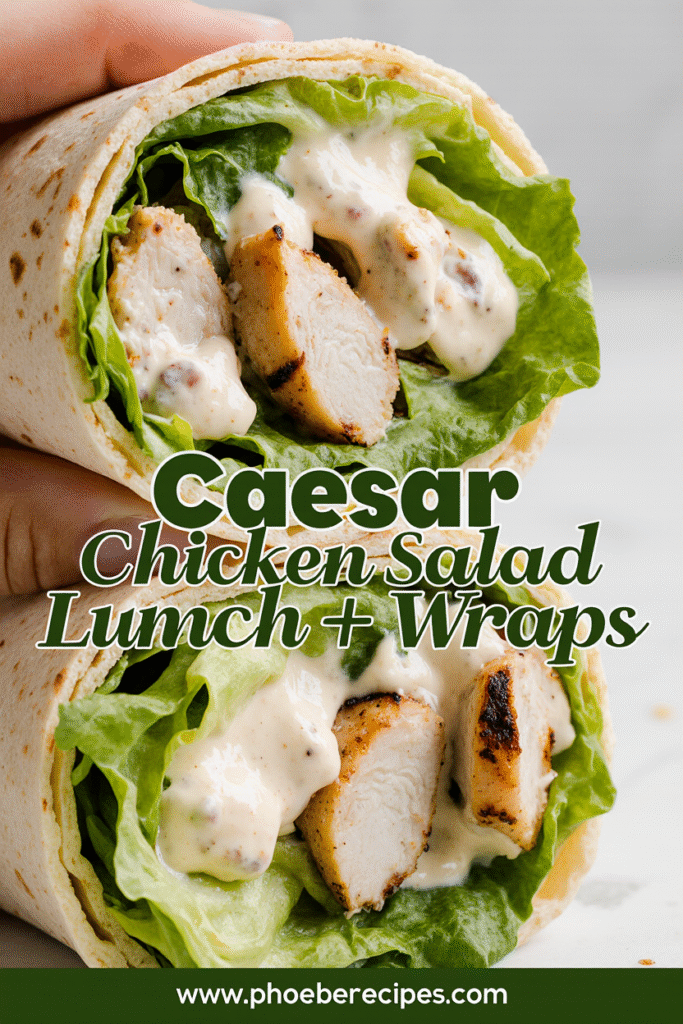The Perfect Chicken Caesar Wrap: Chef Secrets for Restaurant-Style Results
The chicken caesar wrap has come a long way since its inspiration – the original Caesar salad – was invented in 1924 by Caesar Cardini in Tijuana, Mexico. This simple yet delicious meal combines all the classic elements we love in a Caesar salad: crisp romaine lettuce, creamy dressing, Parmesan cheese, and crunchy croutons, all wrapped up with protein-rich chicken in a convenient tortilla.
What I love about making chicken caesar wraps at home is not only their quick 10-minute preparation time but also their incredible versatility. Whether you’re using grilled chicken, rotisserie, or even leftover chicken from yesterday’s dinner, these wraps offer a practical solution for meal prep while reducing food waste. Additionally, they can be prepared ahead of time and stored in the refrigerator for up to 2 days, making them perfect for our busy lifestyles. In this guide, I’ll share professional techniques for creating the perfect chicken caesar salad wrap, from selecting ingredients to mastering the wrapping technique for restaurant-style results every time.
Choosing the Right Ingredients for a Chicken Caesar Wrap
The foundation of any exceptional chicken caesar wrap lies in selecting top-quality ingredients. Each component plays a crucial role in creating that perfect balance of flavors and textures you’d expect from a restaurant-quality wrap.
Chicken: grilled, rotisserie, or homemade
First and foremost, your choice of chicken can make or break your wrap. For the quickest option, rotisserie chicken from the grocery store provides excellent flavor and moisture with zero cooking effort. Alternatively, grilled chicken offers a wonderful charred flavor that complements the caesar dressing beautifully. If you prefer to cook from scratch, consider lightly pounding chicken breasts to about ½-inch thickness to ensure even, quick cooking without drying out. Furthermore, leftover chicken works wonderfully—this wrap is an excellent way to transform yesterday’s dinner into today’s lunch.
Romaine lettuce vs. other greens
Regarding the greens, romaine lettuce remains the classic choice for a reason. Its crisp texture provides that signature crunch and stands up well to creamy dressing without wilting. In contrast, if you’re looking to experiment, kale offers an earthier, more robust alternative with additional nutritional benefits. Spinach provides a softer texture and milder flavor, while arugula can add a peppery kick. Butterhead lettuce creates a more delicate wrap with its soft, buttery texture.
Store-bought vs. homemade Caesar dressing
The dressing ultimately determines the flavor profile of your wrap. Homemade caesar dressing delivers brighter flavors since it uses fresh ingredients without preservatives. A simple homemade version can include mayonnaise, lemon juice, spicy brown mustard, Parmesan, and Worcestershire sauce. Nevertheless, if time is limited, quality store-bought options work well—look for those containing real Parmesan and garlic rather than just flavoring.
Freshly grated Parmesan and crouton options
For authentic flavor, always choose freshly grated Parmigiano-Reggiano cheese (identifiable by the name stamped on the rind). Pre-shredded options save time but sacrifice some flavor complexity. Meanwhile, croutons add essential texture contrast—homemade versions offer superior crunch and flavor customization, though store-bought varieties work in a pinch. Some chefs even crush the croutons slightly to distribute them more evenly throughout the wrap.
Best tortillas for wrapping
The final element—yet equally important—is your tortilla selection. Extra-large or burrito-sized tortillas (approximately 10 inches wide) are ideal as they provide ample space for filling and easier wrapping. Briefly warming your tortilla in the microwave or over a gas flame increases flexibility and prevents tearing. For variety, consider specialty options like spinach or sun-dried tomato tortillas that add subtle flavor dimensions to your wrap.
How to Make the Chicken Caesar Salad Base
Creating the perfect chicken caesar salad base is where the magic happens in your wrap. This mixture forms the heart of your sandwich, determining its flavor, texture, and overall appeal.
Shredding and seasoning the chicken
First, prepare your chicken appropriately. After cooking your chicken breast until it reaches an internal temperature of 165°F, allow it to rest for at least 5 minutes to redistribute juices. This simple step ensures maximum flavor and juiciness. When shredding, pull the cooled chicken apart into bite-sized pieces using two forks or your fingers for a more rustic texture.
For extra flavor, consider marinating your chicken before cooking. A simple marinade of olive oil, lemon juice, garlic, and herbs creates wonderfully flavorful meat. Alternatively, season cooked rotisserie chicken with salt, pepper, and garlic powder to enhance its taste before adding it to your mix.
Mixing in dressing, cheese, and veggies
Once your chicken is ready, gather a large mixing bowl – you’ll need space to toss everything evenly. Combine your shredded chicken, chopped romaine lettuce, freshly grated Parmesan cheese, and croutons. For additional freshness and color, consider adding halved cherry tomatoes.
Pour approximately 1/2 cup of Caesar dressing over the mixture. Start with less dressing than you think you need – you can always add more after tasting. Use tongs to toss gently until everything is evenly coated.
Balancing creaminess and crunch
The perfect chicken caesar wrap requires textural balance. Too much dressing creates sogginess, yet too little leaves the wrap dry. After initial mixing, taste your salad base and adjust accordingly.
For optimal crunch, consider these techniques:
- Roughly chop your croutons into smaller pieces for better distribution
- Add croutons just before wrapping to maintain their texture
- Ensure lettuce is completely dry before mixing to prevent sogginess
Most importantly, let your personal preference guide you. Some prefer a creamier base with extra dressing, whereas others enjoy more emphasis on the crunch. After mixing, season with fresh ground pepper and additional salt if needed.
Assembling and Rolling the Perfect Wrap
After preparing your delicious chicken caesar salad base, the art of assembly and proper rolling technique will transform your ingredients into a perfectly portable meal. The difference between a restaurant-quality wrap and a disappointing, falling-apart mess often comes down to these final crucial steps.
Tossing salad and chicken together
Initially, combine your chicken, romaine lettuce, Parmesan cheese, and croutons in a large bowl. Use tongs to toss the mixture until everything is evenly coated with dressing. This ensures consistent flavor throughout your wrap. Subsequently, taste and season with salt and black pepper if needed. For best results, go light on the dressing during this step—you can always serve extra on the side for dipping.
Layering ingredients on the tortilla
Place your tortilla on a flat, clean surface. First, warm the tortilla for about 15-30 seconds in the microwave or in a dry skillet—this makes it more pliable and prevents tearing. Then, spoon the chicken caesar mixture onto the center of the tortilla, leaving a two-inch border around the edges. Avoid the common mistake of overfilling; use approximately 1-2 cups of filling per wrap, depending on tortilla size.
Step-by-step wrap folding technique
- Fold in the sides of the tortilla toward the center, leaving about an inch between them
- Bring the bottom edge up and over the filling, tucking it under slightly
- Continue rolling forward, keeping the side edges tucked in as you go
- Apply gentle pressure to create a tight roll
- Place seam-side down to help seal the wrap
Tips to prevent tearing or sogginess
To prevent tearing, always use large (10-inch) flour tortillas and warm them before rolling. Furthermore, wrap your finished chicken caesar wrap in parchment paper or foil to maintain its shape and keep moisture out.
To avoid sogginess, consider these professional tricks: pack dressing separately for dipping, let warm ingredients cool before assembly, and place moisture-heavy ingredients in the center rather than against the tortilla. Moreover, butter the inside of your tortilla to create a moisture barrier if you’re preparing the wrap ahead of time.
Make-Ahead, Storage, and Serving Tips
Mastering the chicken caesar wrap doesn’t end with assembly – knowing how to store and serve these delicious handheld meals can elevate your experience from good to exceptional.
Meal prep strategies for busy days
For hectic weekdays, prepping ingredients separately offers maximum flexibility. Rather than assembling complete wraps, store chicken caesar components individually. Cooked chicken stays fresh for 5-6 days when refrigerated properly, while prepared caesar dressing can last up to 2 weeks in the fridge. For morning meal prep, consider grilling chicken breasts every Sunday for the week ahead. Alternatively, shred rotisserie chicken using a hand mixer for quick and easy preparation.
How to store wraps without sogginess
The enemy of any good wrap is excess moisture. To prevent soggy tortillas, use these chef-approved techniques:
- Layer strategically by placing lettuce first as a moisture barrier between wet ingredients and the tortilla
- Store dressing separately in single-serve containers
- Wrap completed sandwiches tightly in parchment paper or foil
- If assembling ahead, consider buttering the inside of the tortilla to create a moisture barrier
Properly stored wraps stay fresh for 1-2 days in the refrigerator, although most sources recommend consuming within 24 hours for optimal texture.
Serving ideas and side dish pairings
Chicken caesar wraps shine alongside simple, complementary sides. For quick options, serve with baby carrots, fresh fruit, or potato chips. For more substantial meals, consider pasta salad, potato salad, or roasted vegetables. Sweet potato fries provide a nutritious alternative to traditional sides, while a cup of soup creates a satisfying restaurant-style lunch experience.
Can you freeze a chicken caesar wrap?
Most experts advise against freezing fully assembled wraps as lettuce doesn’t freeze well. However, you can freeze the chicken component for up to 3 months. For those willing to experiment, some sources suggest freezing assembled wraps for up to 6 months when properly wrapped. When reheating from frozen, wrap in a damp paper towel before microwaving or use an air fryer after lightly spraying with oil.
Conclusion
Chicken caesar wraps undoubtedly offer one of the most satisfying combinations of flavor, convenience, and versatility for busy food lovers. Throughout this guide, we’ve explored everything from selecting premium ingredients to mastering professional wrapping techniques that ensure restaurant-quality results every time.
Remember that the magic of a perfect wrap lies in balance. Too much dressing creates sogginess, while insufficient amounts leave your wrap disappointingly dry. Similarly, warming your tortilla before assembly prevents frustrating tears, and strategic layering keeps everything intact until the last bite.
What makes these wraps truly special, however, is their adaptability to your lifestyle. You can prepare components ahead of time, customize ingredients based on preferences, and transform leftover chicken into something exciting and new. Additionally, their portable nature makes them perfect for lunches, picnics, or quick dinners when time runs short.
My favorite aspect remains their delicious simplicity. Despite requiring minimal effort, these wraps consistently deliver maximum satisfaction. The combination of creamy dressing, crunchy romaine, savory chicken, and cheesy goodness wrapped in a soft tortilla simply works – a culinary formula perfected over decades since Caesar Cardini’s original salad creation.
Next time you crave a restaurant-quality meal without the restaurant price tag, give these chicken caesar wrap techniques a try. Your taste buds will thank you, and your meal prep routine might change forever. After all, few meals offer this perfect blend of convenience, flavor, and satisfaction in one tidy package.


